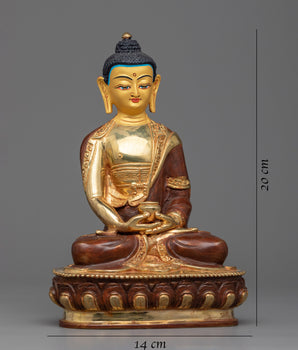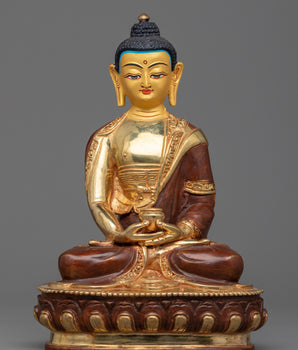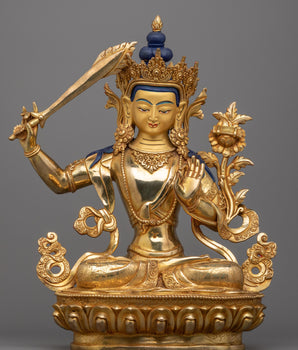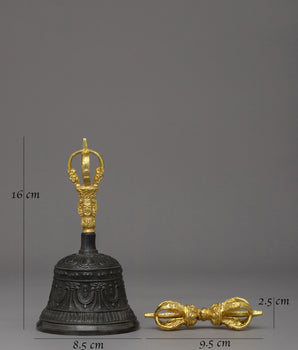












Radiant Oxidized Guru Rinpoche Statue | Vajra Master Padmasambhava

100% AUTHENTIC

HANDMADE

FREE SHIPPING
Handmade Radiant Oxidized Guru Rinpoche Statue for Dharma Decor
-----------------------------------------------------------------------
Size: 8.7”/22cm (Height) x 5.9”/15cm (Base)
Weight: 1.35 kg
Material: Oxidized Copper Body, Silver Plated
-----------------------------------------------------------------------
About Our Statue:
The Lotus Born Master Padmasambhava Statue, also known as Padmasambhava, the founder of Tibetan Buddhism, represents enlightenment, compassion, and spiritual mastery. This handcrafted statue is 8.7" (Height) x 5.9" (Base) and weighs 1.35 kg. It is made of oxidized copper. Created by expert Nepalese artisans, it represents Himalayan Buddhism's holy traditions, making it an appealing addition to altars, meditation places, or sacred collections.
Guru Rinpoche is represented sitting in a royal posture, presenting confidence and spiritual mastery. His right hand holds a vajra, which represents indestructible power while his left hand holds a skull cup (kapala) filled with the nectar of wisdom. The khatvanga, a trident ornamented with symbolic components reflecting his tantric attainment and the union of wisdom and compassion, rests on his left shoulder.
Guru Rinpoche, also called Padmasambhava, holds a special place in Tibetan Buddhism as the revered "Second Buddha." Legend has it that he brought Buddhism to Tibet in the 8th century, weaving together wisdom, compassion, and powerful transformation. His iconic symbols—the vajra, skull cup, and trident—tell tales of his triumph over challenges and his gift for banishing ignorance. Invoked as a guardian and spiritual mentor, Guru Rinpoche blesses followers with insight and the path to enlightenment.
Introduction To Guru Rinpoche :
Guru Rinpoche was an instrumental figure in Tibetan Buddhism. In Tibetan Buddhism, Padmasambhava's teachings are said to have an oral lineage (kama) and a lineage of the hidden treasure texts (termas). He is said to appear in visionary encounters to tertöns, and his form is visualized during guru yoga practice, particularly in the Nyingma school. He is revered by Buddhists in Tibet, Nepal, Bhutan, India's Himalayan states, and other countries worldwide.
How do you take care of your statues?
• Place them at room temperature, avoiding direct sunlight.
• Make sure that the area where your statue is placed is entirely free of moisture and dust.
• Place it at the highest place on your altar after being consecrated by a Lama/monks. The best practice is to keep them covered inside a glass cabinet.
• Do not use your bare hands or any objects with a rough surface to wipe the face. Directly touching objects with the bare hand can smudge the face, leaving scratches.























